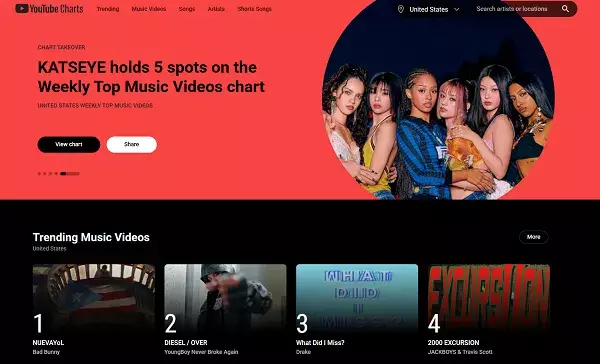Since its inception in 2015, YouTube’s “Trending” feature served as a primary gateway for users to identify what was popular across the platform. It was a straightforward list—viral videos everyone watched or talked about. Over time, however, this simplicity has become a liability in an increasingly complex digital landscape. As the platform evolved, so did the nature of viral content, fragmenting across countless niches, fandoms, and micro-trends. The traditional “Trending” pages, once a pulse of the collective zeitgeist, now seem ill-equipped to accurately reflect the dynamic diversity of content that users engage with daily.
YouTube’s decision to phase out its “Trending” and “Trending Now” sections signifies a fundamental shift in content discovery strategy. Instead of a universal trend list, the platform now emphasizes category-specific charts that mirror the multifaceted way viewers seek entertainment and information. This approach aligns more precisely with contemporary user behaviors, which are increasingly niche-oriented and driven by personalized recommendations rather than broad, sweeping trend alerts. By doing so, YouTube acknowledges the sophisticated ecosystem of communities and micro-trends that evolve faster than a monolithic “trending” list can capture.
personalization Over Broad Trends: A Tactical Shift in User Engagement
The heart of YouTube’s new strategy revolves around tailored content discovery. Instead of presenting users with a one-size-fits-all chart of what’s hot, the platform now offers segmented charts—such as Trending Music Videos, Weekly Top Podcasts, or Trending Movie Trailers—dedicated to specific interests. This approach represents an attempt to not just reflect popular culture, but to encourage deeper exploration within individual communities.
For content creators and viewers alike, this is a double-edged sword. On one side, it offers a more nuanced pathway to visibility. Creators focused on niche genres or specific topics are likely to see their work promoted in relevant categories, which could foster more meaningful engagement. On the other, the disappearance of broad trend highlights from the front page or in-stream sections might reduce the casual discovery of viral videos that cut across interests. In essence, YouTube is betting that personalized, category-specific recommendations will foster more authentic engagement than generic trend lists.
However, the reliance on algorithmic personalization has its critics. If the platform’s algorithms favor familiar interests, they risk reinforcing echo chambers and narrowing the diversity of content exposed to users. This could diminish the platform’s role as a space for discovering the unexpected or unexplored. Furthermore, the removal of prominent trending sections might implicitly signal a less communal and more segmented experience, potentially fragmenting what was once a shared digital moment.
The Cultural Implications of a More Fragmented Discovery System
This move signals a philosophical shift in how YouTube perceives its role as a cultural aggregator. Previously, trending lists acted as a digital Mirror of the zeitgeist—providing a snapshot of what the world was consuming en masse. Disabling these broad trend features could be interpreted as a move away from that role, emphasizing individualized content paths over collective moments.
While this may serve the interests of niche communities and dedicated followers, it risks diluting the collective cultural pulse that the old trend pages fostered. Without flagship trend lists, there’s less immediate visibility for videos that have mass appeal across demographics. The broader social value of shared cultural moments—the viral videos everyone talks about—might be diminished as the platform encourages users to stick to their personalized bubbles.
Nevertheless, YouTube justifies this shift by arguing that its personalized recommendation system already effectively delivers popular content tailored to individual interests. The platform’s focus on keeping users engaged through continuous scrolling and algorithmic suggestions suggests an understanding that discovery through seamless feeds is more sustainable than episodic trend updates. Here, YouTube opts for depth over breadth, trusting that a more refined content ecosystem will be more sustainable in the long term.
Will This Change Foster a More Genuine Engagement or Fracture the Platform?
Ultimately, this pivot towards specialized charts and away from broad trend lists is a bold gamble. It might incentivize creators to tailor their content to specific categories, fostering authentic community building within niches. For viewers, it offers an opportunity to dive deeply into topics they care about, without the noise of viral fluff overshadowing the substantive.
Yet, there remains an undercurrent of concern: does this move risk creating silos, limiting the platform’s ability to foster cross-pollination of ideas and trends? Will the disappearance of global trend lists lead to a less unified cultural space? Perhaps, but it’s also possible that YouTube’s algorithmic underpinnings will evolve to compensate, surfacing unexpectedly popular content within the personalized streams.
In a sense, the platform’s new direction signifies a broader philosophical debate about the future of content discovery. It raises questions about whether we prefer the serendipity of broad trend lists or the precision of personalized storytelling. The outcome will ultimately depend on how well YouTube balances the diverse needs of its global community, nurturing both micro-community visibility and occasional cross-niche collision.

